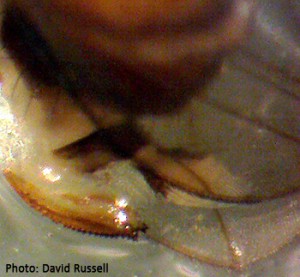On July 6, 2016 first catch of 1 female and 3 male SWD was found in a raspberry planting in Orange County. The following week, 2 female and 4 male SWD had been caught in the traps, indicating sustained catch. Traps at this location are being monitored by Tim Lamposona, technician with Peter Jentsch’s entomology program, Hudson Valley Research Lab, Cornell University, Highland, NY.
Category: SWD reports
SWD found in St. Lawrence County
Eight female and one male SWD were caught on July 23, 2016 in traps set on the edge of a red raspberry planting in St. Lawrence County by Paul Hetzler, who works with Cornell Cooperative Extension of St. Lawrence County.
Onondaga County first find
Two male and 12 female SWD were caught in traps on July 26, 2016 that were set in a blueberry planting in Onondaga County. Much of the planting had reduced crop load due to winter damage. These traps are being monitored by Nicole Mattoon, technician, and Juliet Carroll, Fruit IPM Coordinator, NYS IPM Program.
Although SWD had been caught earlier in an adjacent insecticide timing trial in raspberry with abundant fruit nothing had been caught in the blueberries until now. This underlines how much more attractive raspberry is to SWD than blueberry.
If you have ripe fruit on your farm, take time to monitor, check fruit for infestation, and develop an integrated management plan that includes refrigeration soon after harvest. Populations of SWD will continue to build up through the summer and into the fall.
Genesee County sustained catch
Sustained capture in traps checked on July 18, 2016, in Genesee County found 10 female and 1 male SWD. These traps are set in a fall raspberry planting in which fruit are just beginning to ripen.
Traps in Genesee County are being monitored by David Russell, Master Gardener, and Jan Beglinger, association community educator, with the Cornell Cooperative Extension Association of Genesee County.
Informed decision-making is best. Read guidelines for dealing with SWD:
Find this information and more on the Cornell Fruit Resources Spotted Wing Drosophila website.
Niagara County sustained catch
SWD populations are building! The sustained capture in traps checked on on July 15, 2016, in Niagara County found 12 female and 6 male SWD. Berry crops are ripe and ripening. Summer raspberry harvest is nearing completion, fall raspberries are ripening and blueberry harvest is beginning and the crop is ripening.
Traps in Niagara County are being monitored by Liz Tee, technician, and Tess Grasswitz, Extension educator, with the Lake Ontario Fruit Program of Cornell Cooperative Extension.
Find information and resources on the Cornell Fruit Resources Spotted Wing Drosophila website.
Orleans County sustained catch
Both sites in Orleans County where SWD traps are being monitored had sustained trap catch on July 15, 2016. One site is a raspberry planting with ripe fruit and the other a blueberry planting where fruit are ripening. First find was on July 8, 2016, and this report wasn't posted to the blog (my apologies to the readers for not posting this sooner). First catch in both crops was of a single female SWD. Sustained catch was of two females at each location.
These traps are being monitored by Liz Tee, technician, and Tess Grasswitz, Extension educator, with the Lake Ontario Fruit Program of Cornell Cooperative Extension.
Do keep a close eye on your berry crops!
Find information on the Cornell Fruit Resources Spotted Wing Drosophila website.
Albany County sustained catch
This report came in June 27, 2016—my apologies for not sending it out sooner. Four female SWD were caught, one in each trap at this Albany County summer raspberry site. These traps are being monitored by Annie Mills, technician, and Laura McDermott, Extension educator, with the Eastern NY Commercial Horticulture Program of Cornell Cooperative Extension.
This was the second consecutive week of trap catch indicating sustained trap captures. Once sustained catch was attained, traps at this site were taken down.
Keep a close eye on your berries, plan to protect them from SWD. Practice clean picking, sanitation and post-harvest refrigeration (below 40°F, preferably ~35°F) to keep SWD populations down. Find information on the Cornell Fruit Resources Spotted Wing Drosophila website.
Washington County sustained catch
Two female and two male SWD were caught in traps checked on July 12, 2016 that are set in a blueberry planting in Washington County. These traps are being monitored by Annie Mills, technician, and Laura McDermott, Extension educator, with the Eastern NY Commercial Horticulture Program of Cornell Cooperative Extension.
This is the second consecutive week of trap catch indicating sustained trap captures. Once sustained catch is attained, traps in the network are taken down.
A fruit sample was collected from this planting and checked via salt flotation - no eggs or larvae were found in the fruit.
Do keep a close eye on your berry crops, plan to protect them from SWD, and practice clean picking, sanitation and post-harvest refrigeration to keep SWD populations down. Find information on the Cornell Fruit Resources Spotted Wing Drosophila website.
Saratoga County sustained catch
For two weeks in a row, SWD has been caught in traps set in a blackberry planting in Saratoga County. Four male and two female SWD were caught this week in traps checked on July 12, 2016, indicating that populations in this location are building up. These traps are being monitored by Annie Mills, technician, and Laura McDermott, Extension educator, with the Eastern NY Commercial Horticulture Program of Cornell Cooperative Extension.
Genesee County first find
One female SWD was caught in traps checked on July 12, 2016 in a raspberry planting in Genesee County. The fruit at this location is ripe and ripening. These traps are being monitored by David Russell, Master Gardener, who is working with Jan Beglinger, Agriculture Outreach Coordinator, Genesee County Cornell Cooperative Extension.


